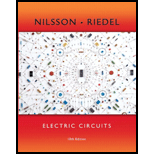
Concept explainers
a)
Find the phase sequence for the given set of voltages.
a)
Answer to Problem 1P
The phase sequence is abc sequence.
Explanation of Solution
Given data:
Consider the set of voltages.
Calculation:
Convert the voltage in Equation (1) from cosine voltage form to phasor form.
Convert the voltage in Equation (2) from cosine voltage form to phasor form.
Convert the voltage in Equation (3) from cosine voltage form to phasor form.
Subtract the phase angle of a-phase from all the phase angles of
And
From Equations (4), (5), and (6), the voltage at phase-b lags a-phase voltage by
Conclusion:
Thus, the phase sequence is abc sequence.
b)
Find the phase sequence for the given set of voltages.
b)
Answer to Problem 1P
The phase sequence is acb sequence.
Explanation of Solution
Given data:
Consider the set of voltages.
Calculation:
Convert the voltage in Equation (7) from cosine voltage form to phasor form.
Convert the voltage in Equation (8) from cosine voltage form to phasor form.
Convert the voltage in Equation (9) from cosine voltage form to phasor form.
Subtract the phase angle of a-phase from all the phase angles of
And
From Equations (10), (11), and (12), the voltage at phase-b leads a-phase voltage by
Conclusion:
Thus, the phase sequence is acb sequence.
Want to see more full solutions like this?
Chapter 11 Solutions
Electric Circuits (10th Edition)
 Introductory Circuit Analysis (13th Edition)Electrical EngineeringISBN:9780133923605Author:Robert L. BoylestadPublisher:PEARSON
Introductory Circuit Analysis (13th Edition)Electrical EngineeringISBN:9780133923605Author:Robert L. BoylestadPublisher:PEARSON Delmar's Standard Textbook Of ElectricityElectrical EngineeringISBN:9781337900348Author:Stephen L. HermanPublisher:Cengage Learning
Delmar's Standard Textbook Of ElectricityElectrical EngineeringISBN:9781337900348Author:Stephen L. HermanPublisher:Cengage Learning Programmable Logic ControllersElectrical EngineeringISBN:9780073373843Author:Frank D. PetruzellaPublisher:McGraw-Hill Education
Programmable Logic ControllersElectrical EngineeringISBN:9780073373843Author:Frank D. PetruzellaPublisher:McGraw-Hill Education Fundamentals of Electric CircuitsElectrical EngineeringISBN:9780078028229Author:Charles K Alexander, Matthew SadikuPublisher:McGraw-Hill Education
Fundamentals of Electric CircuitsElectrical EngineeringISBN:9780078028229Author:Charles K Alexander, Matthew SadikuPublisher:McGraw-Hill Education Electric Circuits. (11th Edition)Electrical EngineeringISBN:9780134746968Author:James W. Nilsson, Susan RiedelPublisher:PEARSON
Electric Circuits. (11th Edition)Electrical EngineeringISBN:9780134746968Author:James W. Nilsson, Susan RiedelPublisher:PEARSON Engineering ElectromagneticsElectrical EngineeringISBN:9780078028151Author:Hayt, William H. (william Hart), Jr, BUCK, John A.Publisher:Mcgraw-hill Education,
Engineering ElectromagneticsElectrical EngineeringISBN:9780078028151Author:Hayt, William H. (william Hart), Jr, BUCK, John A.Publisher:Mcgraw-hill Education,





